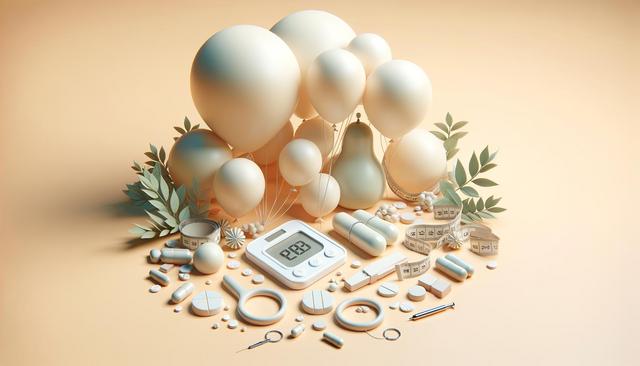What Are Weight Loss Balloons?
Weight loss balloons, also known as intragastric balloons, are medical devices designed to help individuals who struggle with obesity or excess weight. These balloons are inserted into the stomach through a minimally invasive procedure, typically via endoscopy, and then filled with a saline solution or gas. By occupying space in the stomach, they create a feeling of fullness, which helps reduce food intake and supports weight loss efforts. This method is often considered by individuals who have not achieved substantial results through diet and exercise alone and want to avoid or postpone bariatric surgery.
There are several types of weight loss balloons available, each with different features and durations of use. Most are temporary and remain in the stomach for about six months, although some newer types can be swallowed in capsule form and do not require endoscopic removal. It’s important to note that weight loss balloons are not a permanent solution but a tool to assist with lifestyle changes. They are typically part of a broader weight management program that includes nutrition counseling, exercise, and behavioral support.
How Do Weight Loss Balloons Work?
The primary mechanism behind weight loss balloons is their ability to reduce the volume of the stomach, which leads to earlier satiety and reduced hunger. When the balloon is in place, the individual feels full after eating smaller portions, making it easier to adhere to a calorie-restricted diet. This physical sensation, combined with structured dietary guidance, can significantly improve weight loss outcomes while the balloon is in use.
In addition to the physical effects, weight loss balloons can also have psychological benefits. Seeing progress in the early stages of a weight loss journey can motivate individuals to stick to healthier habits. However, successful outcomes depend heavily on the commitment to lifestyle changes, as the balloon is only a temporary aid. Without sustained effort, weight regain is possible after the balloon is removed. Therefore, medical professionals often recommend comprehensive support programs alongside balloon treatment.
Who Is a Candidate for a Weight Loss Balloon?
Weight loss balloons are typically recommended for individuals with a body mass index (BMI) between 30 and 40 who have not been able to lose weight through conventional strategies. They may also be considered for people who need to lose weight before undergoing another medical procedure, such as surgery, to reduce health risks associated with obesity.
Before placement, candidates undergo medical evaluations to ensure they are suitable for the procedure. This includes:
- A thorough health assessment to rule out contraindications such as gastrointestinal conditions.
- Consultation with a multidisciplinary team including a physician, dietitian, and sometimes a psychologist.
- An understanding of the commitment required to follow through with dietary and lifestyle changes.
Not everyone is eligible for a weight loss balloon. Individuals with certain gastrointestinal issues, previous stomach surgeries, or specific medical conditions may not be suitable candidates. A healthcare provider can help determine if this method aligns with a person’s health goals and medical background.
Benefits and Limitations of Weight Loss Balloons
Weight loss balloons offer several advantages for those looking for a non-surgical weight loss option. Among the most commonly cited benefits are:
- Minimally invasive placement and removal procedures.
- Temporary and reversible nature of the device.
- Support for early-stage weight loss to encourage long-term habits.
Despite these benefits, there are limitations to consider. The amount of weight lost can vary significantly depending on the individual’s adherence to the program. On average, people lose between 10% and 15% of their total body weight while using the balloon. Side effects such as nausea, vomiting, and abdominal discomfort are common in the first few days following insertion but usually subside.
Additionally, since the balloon is removed after a set period, there is a risk of regaining weight if lifestyle changes are not maintained. For this reason, the success of the balloon is closely tied to the support structure surrounding it, including regular follow-ups, nutritional planning, and behavioral therapy.
What to Expect During and After the Procedure
The process of getting a weight loss balloon starts with a consultation and medical evaluation. Once approved, the balloon is placed during a short outpatient procedure, usually under mild sedation. The entire process typically takes 20 to 30 minutes, and most patients can return home the same day.
After the procedure, patients may experience some temporary side effects as the body adjusts. These often include:
- Nausea and vomiting
- Mild abdominal cramping
These symptoms usually resolve within a few days. During the months the balloon is in place, patients follow a structured diet plan and attend regular check-ins with their healthcare team. After removal, continued support is essential to maintain weight loss. Many programs offer extended follow-up care to help individuals transition to long-term lifestyle changes successfully.
It’s also important to be mentally prepared for the commitment required. A weight loss balloon is not a quick fix, but with dedication and support, it can be a valuable step toward healthier living.
Conclusion: Is a Weight Loss Balloon Right for You?
Weight loss balloons can be a helpful tool for individuals seeking an alternative to more invasive procedures. They provide an opportunity to jumpstart weight loss efforts while developing sustainable habits. However, success depends on a strong commitment to dietary and lifestyle changes, along with professional support.
If you’re considering this option, consult with a healthcare provider to discuss your goals, medical history, and the suitability of a weight loss balloon for your specific needs. With the right guidance and mindset, this method can support your journey to improved health and well-being.












